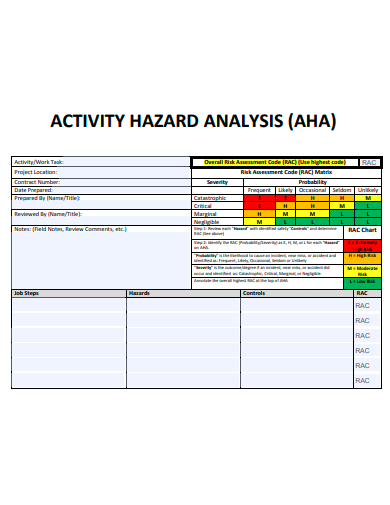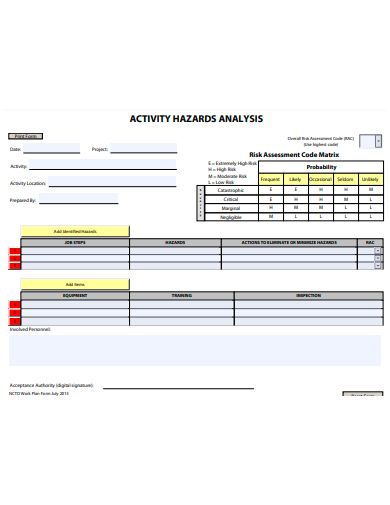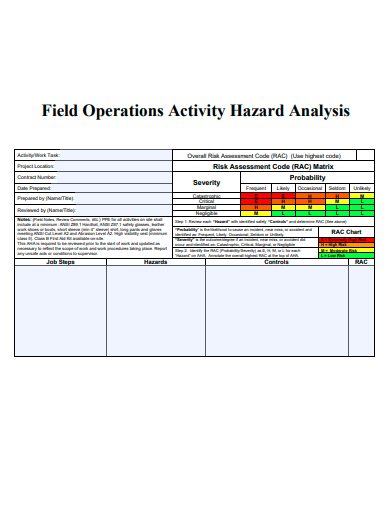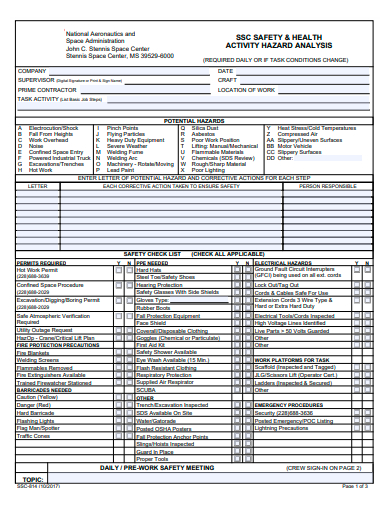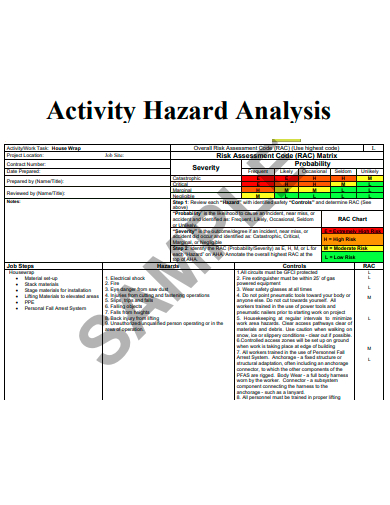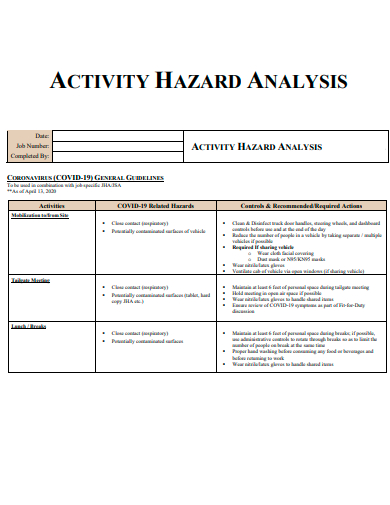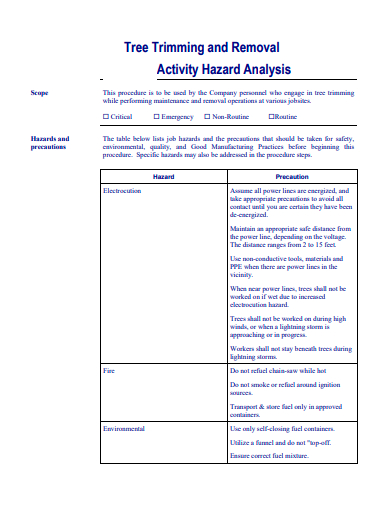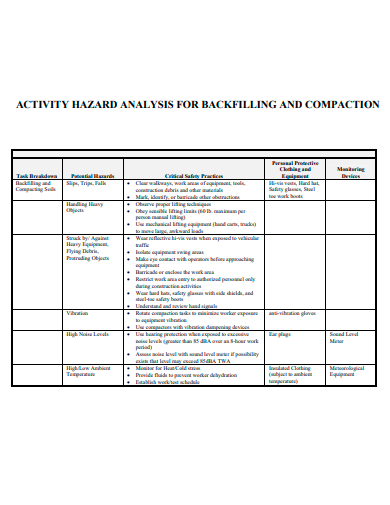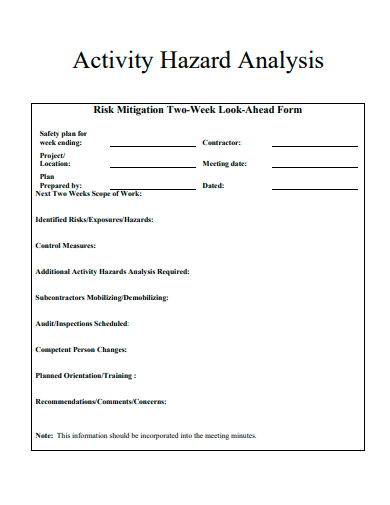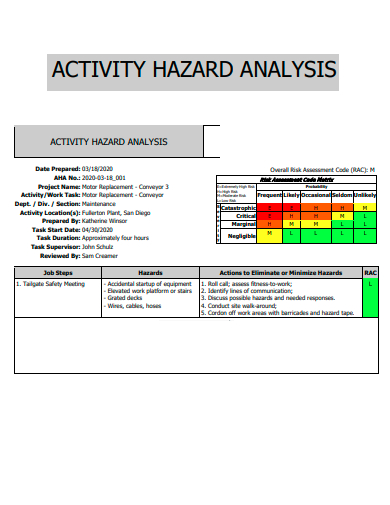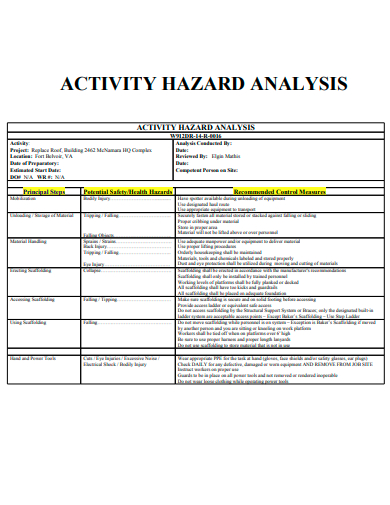Effective risk management includes the identification of hazards and the possible threats should be evaluated and determined whether they are manageable or not. Conducting risk analysis in the earlier lifecycle of an activity will provide a safer operation of the process will be. A risk or hazard analysis is not only used during projects but also in food safety assessment which ranges from the production of the raw materials, ordering and managing, to manufacturing, distribution, and consumption of the final product.
FREE 10+ Activity Hazard Analysis Samples
1. Activity Hazard Analysis Template
2. Basic Activity Hazard Analysis
3. Field Operations Activity Hazard Analysis
4. Safety and Health Activity Hazard Analysis
5. Sample Activity Hazard Analysis
6. Formal Activity Hazard Analysis
7. Activity Hazard Analysis Example
8. Activity Hazard Analysis in PDF
9. Printable Activity Hazard Analysis
10. Activity Hazard Analysis Format
11. Simple Activity Hazard Analysis
What is an Activity Hazard Analysis?
An activity hazard analysis, also known as the job safety analysis or job hazard analysis, refers to a document that records the methods or procedures in which the necessary steps during working operations are indicated. It also includes the possible risks involved in a workplace as they exist and the corrective action plan that an employee must perform. This analysis must be observed before a project and then can be changed as safety conditions during an operation change.
How do I Conduct an Activity Hazard Analysis?
Hazards refer to events that can possibly cause harm, injuries, and other unwanted occurrences while risks refer to the possibility of personal injury, property loss, or environmental harm that may occur during an operation or project. Utilizing an activity hazard analysis template helps an organization to identify ways to minimize the chances of injury or harm while their employees or staff are working on their project.
1. Identify the Tasks that Must be Performed
Identifying the tasks your team must perform to achieve the goals of your project enables you to determine the hazards that come with it. Constructing a hazard assessment checklist that includes the basic hazard categories will help you decide which proper tools, methods, or equipment to use.
2. Identify the Hazards associated with these Tasks
Some hazards will be easy to identify while some are not. You can identify these hazards by determining which process could go wrong, its cause, the factors that could create injuries, and the factors that could damage your equipment.
3. Describe these Hazards
After identifying the hazards, you can now describe them in detail such as their type and their route of exposure. You can also summarize the frequency and severity of the exposure, the probability of risks, and its consequences.
4. Create a List of Controls
Creating a list of hazard controls enables you to eliminate or reduce the frequency of each hazard by utilizing corrective and preventive actions.
5. Make Safe Working Procedures
You can use the information you have gathered in identifying and describing the hazards in your workplace to make safe working procedures. These procedures should enlist the identified hazards and risks that come with your project and the corresponding controls to be used to minimize the risks.
FAQs
What are the objectives of performing a hazard analysis?
Performing a hazard analysis aims to identify the hazards that come with different work assignments, events, and occurrences, to identify its causes and analyze the course of events that can cause injuries, exposure, and other work accidents, and to determine the risk associated with a specific hazard.
What are the common types of workplace hazards?
The common types of hazards that can happen in your workplace include Safety Hazards, Biological Hazards, Physical Hazards, Ergonomic Hazards, Chemical Hazards, Work Organization Hazards, and Environmental Hazards.
How does the hierarchy of hazard controls work?
The hierarchy of hazard controls should begin with the most effective to the least effective control. The most effective controls include measures to eliminate hazards, substitutions, engineering controls, and administrative controls while the least effective controls include personal protective equipment or PPE.
Activity hazard analysis is a risk assessment and management method to determine and control possible hazards that associate with working assignments by eliminating or minimizing potential injuries or illnesses. This analysis uses a Risk Assessment Code which helps in enabling workers to focus their attention on steps or activities with the highest risk of injury or illness so they can perform proper measures to avoid them.
Related Posts
FREE 7+ Sample Product Risk Assessment Templates in PDF MS ...
FREE 10+ Worksheet Analysis Samples in MS Word Google Docs ...
FREE 10+ Fire Risk Assessment Samples [ Safety, Workplace ...
FREE 10+ Charity Risk Assessment Samples & Templates in PDF ...
FREE 10+ Construction Health And Safety Plan Samples [ Phase ...
FREE 9+ Safety Contract Samples & Templates in PDF MS Word
FREE 10+ Safety Observation Report Samples [ Daily, Officer, Site ]
FREE 37+ Risk Assessment Forms in PDF MS Word
FREE 15+ Sample Safety Reports in PDF Google Docs | Apple ...
FREE 10+ Qualitative Risk Assessment Samples in PDF DOC
FREE 11+ Retail Risk Assessment Samples in PDF MS Word
FREE 10+ Sample Risk Assessment Checklist Templates in Google ...
FREE 10+ Construction Safety Emergency Plan Samples in MS ...
FREE 10+ Risk Matrix Samples in PDF MS Word
FREE 10+ Liability Risk Assessment Samples and Templates in PDF

